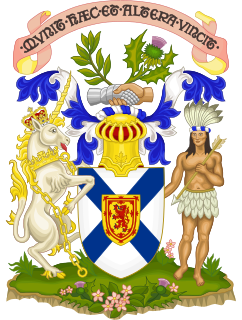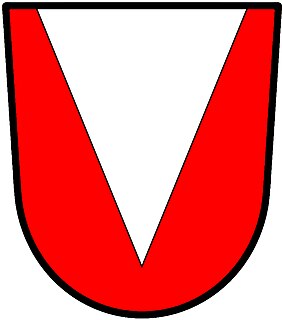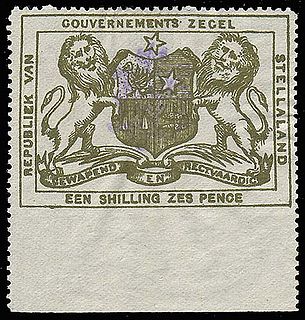
The coat of arms of Stellaland was the official heraldic symbol of the short-lived Stellaland state in South Africa from 1883 to 1885. It was later revived as the municipal arms of Stellaland's capital, Vryburg.

The coat of arms of Stellaland was the official heraldic symbol of the short-lived Stellaland state in South Africa from 1883 to 1885. It was later revived as the municipal arms of Stellaland's capital, Vryburg.
The coat of arms appears to have been designed and adopted shortly after Stellaland was proclaimed a republic in August 1883. It was depicted on the postage stamps from February 1884. [1] It was also displayed on a green banner, known as the 'standard', which was flown outside the government offices in Vryburg. [2] The Executive Council gave the standard to Queen Victoria of the United Kingdom in 1885 [3] [4] It was returned by her descendant King George V in 1934, and hung in the Vryburg town hall. [2] [5] [6]
The Vryburg municipality adopted the arms in 1931, and were added to the mayor's chain of office in 1956. [2] The arms were formally granted to the municipality by the administrator of the Cape Province in 1966, [7] and registered at the Bureau of Heraldry in 1970. The arms are now used by the Naledi Municipality, North West, into which Vryburg has been incorporated.
The blazon of the arms is :
- Quarterly, I, Argent, a korhaan volant, a dexter hand issuant from a sleeve grasping the sinister foot, all proper; II, Vert, a mullet Argent; III, Azure, a pair of scales Or; IV, Gules, two fishes naiant and counter-naiant in pale Argent pierced by a sword point downward proper.
- Crest : A mullet Or. [Note : the English version of the registered blazon incorrectly gives the star as Argent]
- Motto : Gewapend en regtvaardig ('Armed and justified'). [8]
The korhaan represents the chief Massouw, the star the comet after which Stellaland was named, the scales justice, and the impaled fish the defeated chief Mankaroane.
Some postage stamps show the arms supported by two lions. There is also a painting showing the arms flanked by flags. [2]
The Stellaland postage stamps are monochrome, with the tinctures of the arms indicated by cross-hatching. According to the cross-hatching, quarter 1 should be gold, quarter 2 blue, and quarters 3 and 4 red, as shown in the illustration (right). As these are not the colours of the arms as depicted on the government flag, the postage stamps are evidently incorrect in this respect.

The coat of arms of Saskatchewan is the heraldic symbol representing the Canadian province of Saskatchewan.

The coat of arms of Nova Scotia is the heraldic symbol representing the Canadian province of Nova Scotia. It is the oldest provincial achievement of arms in Canada, and the oldest British coat of arms in use outside Great Britain. It is blazoned as follows: Argent, a saltire azure charged with an escutcheon of the Royal Arms of Scotland.

The Republic of Stellaland was, from 1882 to 1883, a Boer republic located in an area of British Bechuanaland, west of the Transvaal. After unification with the neighbouring State of Goshen, it was the United States of Stellaland from 1883 to 1885.
The lines of partition used to divide and vary fields and charges in heraldry are by default straight, but may have many different shapes. Care must sometimes be taken to distinguish these types of lines from the extremely unusual and non-traditional use of lines as charges, and to distinguish these shapes from actual charges, such as "a mount [or triple mount] in base," or, particularly in German heraldry, different kinds of embattled from castle walls.

In heraldry, variations of the field are any of a number of ways that a field may be covered with a pattern, rather than a flat tincture or a simple division of the field.

In heraldry, an ordinary is a simple geometrical figure, bounded by straight lines and running from side to side or top to bottom of the shield. There are also some geometric charges known as subordinaries, which have been given lesser status by some heraldic writers, though most have been in use as long as the traditional ordinaries. Diminutives of ordinaries and some subordinaries are charges of the same shape, though thinner. Most of the ordinaries are theoretically said to occupy one-third of the shield; but this is rarely observed in practice, except when the ordinary is the only charge.

British Bechuanaland was a short-lived Crown colony of the United Kingdom that existed in southern Africa from its formation on 30 September 1885 until its annexation to the neighbouring Cape Colony on 16 November 1895. British Bechuanaland had an area of 51,424 square miles (133,190 km2) and a population of 84,210. Today the region forms part of South Africa.

The current coat of arms of Zimbabwe was adopted on 21 September 1981, one year and five months after the national flag was adopted. Previously the coat of arms of Zimbabwe was identical to the former coat of arms of Rhodesia.

Vryburg is a large agricultural town with a population of 48,400 situated in the Dr Ruth Segomotsi Mompati District Municipality of the North West Province of South Africa. It is the seat and the industrial and agricultural heartland of the district of the Bophirima region.

The coat of arms of the Cape Colony was the official heraldic symbol of the Cape Colony as a British colony from 1875 to 1910, and as a province of South Africa from 1910 to 1994.

Stellaland was a short-lived Boer republic from 1882 until 1885, located in southern Bechuanaland, west of the then South African Republic, with Vryburg as its capital. It was incorporated in British Bechuanaland in 1885. British Bechuanaland was subsequently incorporated into the Cape of Good Hope in 1895.

The coat of arms of the Western Cape is the official heraldic symbol of the Western Cape province of the Republic of South Africa. It has been in use since 1998.

In heraldry, a pile is a charge usually counted as one of the ordinaries. It consists of a wedge emerging from the upper edge of the shield and converging to a point near the base. If it touches the base, it is blazoned throughout.
This is a survey of the postage stamps and postal history of British Bechuanaland.

The coat of arms of the Orange Free State was the official heraldic symbol of the Orange Free State as a republic from 1857 to 1902, and later, from 1937 to 1994, as a province of South Africa. It is now obsolete.

The coat of arms of the Transvaal was the official heraldic symbol of the South African Republic from 1866 to 1877 and again from 1881 to 1902, and later the symbol of the Transvaal Province from 1954 to 1994 in a simplified form. It is now obsolete.
The coat of arms of the Orange River Colony was the official heraldic symbol of the Orange River Colony as a British colony from 1904 to 1910, and then of the Orange Free State province of South Africa from 1910 to 1925. It is now obsolete.
In heraldry, a stain is one of a few non-standard tinctures or colours, which are only known to occur in post-medieval heraldry and may be used as part of a rebatement of honour. Almost none of these rebatements are found in fact of heraldic practice, however, and in British heraldry the stains find only exceptional use, other than for purposes of livery.

The flag of Stellaland was the official flag of the short-lived southern African Republic of Stellaland, which existed from 1883 to 1885.

Bechuanaland first issued revenue stamps as Stellaland in 1884. Note: this information is wrong. Bechuanaland was split into British Bechuanaland and the Bechuanaland Protectorate. British Bechuanaland was added to the Cape Colony and the Bechuanaland Protectorate was governed from Mafeking until the seat of government was moved to Gaberone.